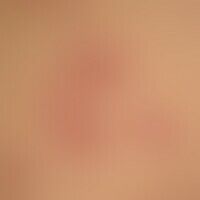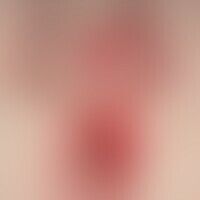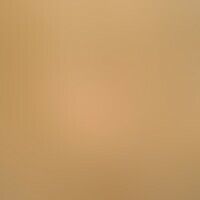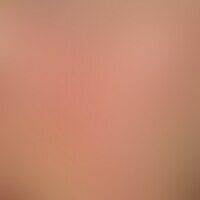Image diagnoses for "Plaque (raised surface > 1cm)"
570 results with 2865 images
Results forPlaque (raised surface > 1cm)

Bowen's disease D04.9
Bowen's disease: chronically stationary, slowly increasing in area and thickness, sharply defined, now clearly (knot formation), symptom-free, red, rough, sometimes scaly and crusty plaque on the palm of the hand.

Dyskeratosis follicularis Q82.8
Dyskeratosis follicularis: Infestation of the palms of the hands; in central areas of the palm flat, common keratoses, at the ball of the thumb about 0.1-0.2 cm large, glassy papules.

Acrodermatitis continua suppurativa L40.2
Acrodermatitis continua suppurativa: for years a chronic recurrent clinical picture with painful pustules, nail destruction with formation of erosive areas

Necrobiosis lipoidica L92.1
Necrobiosis lipoidica: Sharply defined, confluent marginal, reddish-brownish, centrally faded, atrophic plaques, increase in consistency in the marginal area.

Angioimmunoblastic T cell lymphoma C84.4
Angioimmunoblastic T-cell lymphoma: Dress syndrome in AIP. Figure taken from: Mangana Jet al. (2017)

Nevus melanocytic congenital D22.-
Congenital melanocytic nevus. brown, soft, papillomatous plaque sharply demarcated from the surrounding normal skin. no change in colour or shape has been detected so far apart from the "physiological" size growth.

Spindle cell tumor, pigmented D22.L
Pigmented spindle cell tumor, nevus reed: dark brown to black pigmented plaque, preferably located on the lower leg. The lesion is usually excised under the suspected diagnosis of melanoma. Illustration from the collection of Dr. Michael Hambardzumyan.

Erythema anulare centrifugum L53.1
Erythema anulare centrifugum: characteristic (fresh) lesions with peripherally progressive plaques, which are peripherally palpable as well limited (like a wet wolfaden) Histological clarification necessary.

Keratosis palmoplantaris diffusa with mutations in KRT 9 Q82.8
Keratosis palmoplantaris diffusa circumscripta: Thick, waxy, yellowish, plate-like horny layer that covers the entire palm of the hand and also the sole of the foot; the mobility of the hands is restricted.

Infant haemangioma (overview) D18.01

Erythrokeratodermia progressive symmetrica Q82.8

Deposit dermatoses (overview) L98.9
Plaqueform mucinosis of the skin: follicle-accentuating (peau d'orange) deposits of mucin in the skin.

Kaposi's sarcoma (overview) C46.-
Kaposi sarcoma HIV-associated: flat, symptomless plaques; HIV infection known for several years.

Parapsoriasis en plaques benign small foci L41.3
Parapsorisis en petites plaques: completely symptom-free red (hardly palpable), slightly scaly plaques; recurrent course for years; improvement in the summer months or under UV therapy.

Lupus erythematosus acute-cutaneous L93.1
lupus erythematosus acute-cutaneous: clinical picture known for several years, occurring within 14 days, at the time of admission still with intermittent course. anular pattern. in the current intermittent phase fatigue and exhaustion. ANA 1:160; anti-Ro/SSA antibodies positive. DIF: LE - typical.

Leprosy (overview) A30.9
Leprosy. leprosy lepromatosa (-LL-): disease pattern with papules and nodules in diffuse distribution that has been continuously developing for many years; loss of eyebrows, partial loss of eyelashes (Alopecia lepromatosa)








